RESTORATION UP TO 2002
Progress as told by Bob Rees
The Start of it All

In June of 2001, I had a visit from Jim Singer from the Burlington Route Historical Society, and he was doing some research for a Society bulletin. As long as he was in Oregon I suggested we visit the Oregon Railroad Depot. The City gave me the key and that’s when it all started. Jim and I walked through the depot, and our first impression was pretty dismal. Most of the windows were boarded over, there was water on the floors from the leaking roof, and the building was packed with City storage of unwanted items and debris. Jim left, and I left and took the key back. That night I gave a call to Jerry Stauffer in Mount Morris, a town five miles away. I knew of Jerry as a railfan, and we made arrangements to meet at the depot the following day; the wheels had started turning in my brain and the restoration of the depot was taking shape.
After I got the key again, Jerry and I gave the depot a thorough inspection and by the time we had finished we were both hooked on the restoration. Jerry had brought his friend Dennis Kern with him and while we were digging through the interior, Dennis found a broom and swept the remaining brick walkways for the first time in probably 30 years. That was the first actual work to restore the depot. After we left, I returned the key to the city hall, but this time I was told to keep it. That evening Jim Lauer, the city councilman responsible for public buildings, stopped at my home and we had a lengthy visit. When we were finished, I had a go-ahead to start the restoration of the depot with the blessing of the City of Oregon. I was well aware that there was no money appropriated for the project, but the city had agreed to provide necessary materials as long as there weren’t too many, too soon.
The City also provided the files from previous efforts to start the restoration. There had been some preliminary work done by an architect, and some estimates for the restoration had been acquired. The estimates were in the $325,000 range, and the gathered information had been incorporated into a grant application. After spending considerable time researching the available documents, I again met with Jerry to determine how we should approach the project. We decided to first clean out the building and do the best we could to stabilize the building from further deterioration.
Emptying The Building
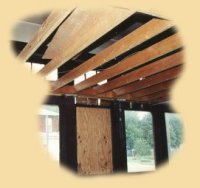
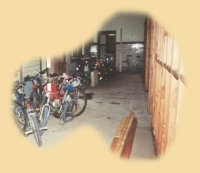
The following weekend was the Fourth of July, and Jerry and I showed up with crowbars and hammers, and we started the demolition of temporary office partitions. Within two days we had removed the false ceilings and all wall partitions and we were back to the original configuration of the Oregon depot. We began filling the first large dumpster that had been provided by the city; the completion of our clean-up would require two more. All of the lumber used for the partitions was salvageable, and it became very useful later for the construction of scaffolding.
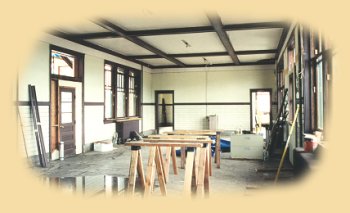 The inside of the building was stacked with bicycles, desks, office cubicles and junk. The ticket office had become a receptacle for the city’s annual Christmas Candle Walk candle containers, and they were stacked half way to the ceiling. We started to clean the room, and what we thought would be a two-hour job, ended up taking the major portion of a day. Along with the thirty-five garbage bags full of cut-off plastic gallon milk jugs, we disposed of dead animal carcasses and other disgusting stuff, but by day’s end we had the room empty. Our next and probably biggest problem was what to do with all of the stored junk that stretched from one end of the building to the other. We decided to have an auction and sell the junk we could, along with any donations made to benefit our cause.
The inside of the building was stacked with bicycles, desks, office cubicles and junk. The ticket office had become a receptacle for the city’s annual Christmas Candle Walk candle containers, and they were stacked half way to the ceiling. We started to clean the room, and what we thought would be a two-hour job, ended up taking the major portion of a day. Along with the thirty-five garbage bags full of cut-off plastic gallon milk jugs, we disposed of dead animal carcasses and other disgusting stuff, but by day’s end we had the room empty. Our next and probably biggest problem was what to do with all of the stored junk that stretched from one end of the building to the other. We decided to have an auction and sell the junk we could, along with any donations made to benefit our cause.
Auctioneer Nate Mattison donated his services, and after the sale we had $1200 to add to our restoration effort. Everything that was left was loaded into a dumpster and we had an empty building for the first time in over 12 years.
Of Windows, Woodwork, and Oregon Alumni
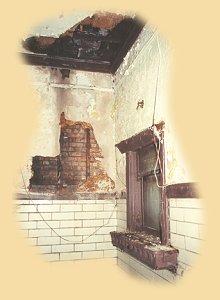 Remarkably, as the windows were uncovered we found all of the sashes intact and only cutouts of the woodwork where the false ceilings had been installed. The ticket window, although seriously damaged from leaking roof water, was intact.
Remarkably, as the windows were uncovered we found all of the sashes intact and only cutouts of the woodwork where the false ceilings had been installed. The ticket window, although seriously damaged from leaking roof water, was intact.
Since I was available during the day, I started by removing the windows to replace the broken glass. Starting in the ticket office, I decided to scrape the sash down to bare wood and repair as best I could, all of the rotten parts. Like Tom Sawyer painting the fence, I soon had volunteers just start to show up and go to work. I passed out keys so everyone could come and go as they had time, and soon we had a production line restoring windows every day. The help on this project came from Ken Giese, Silvia and Max Newcomer, Dean Johnson, Cheri Wright, Marlene Hobbs and Colleen Carlson.
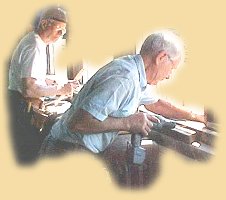 A story I like to tell is that when I was working on one of the first windows, Silvia did one to show me how to do it, and said “There, this is what we want.” I said “Yes and now all you have is 69 more to go,” and she did! Before we reinstalled the windows we also stripped all of the exterior window frames and made repairs as necessary. There was some major repair and that is another story. I had removed a sash whose entire bottom had been rotted away. I really didn’t know what to do next, and in walked Howard Fox, a man of many talents, and who had been working on the restoration of the Chana School. He asked what he could do, and we loaded the sash in his car and he took it home and made new parts and repaired the window. He and Max also replaced a sill that was completely gone. Mervel Wood and Howard worked together on the repair of the ticket window and ticket counter. This entire project has had this magic of volunteers becoming available in very difficult situations.
A story I like to tell is that when I was working on one of the first windows, Silvia did one to show me how to do it, and said “There, this is what we want.” I said “Yes and now all you have is 69 more to go,” and she did! Before we reinstalled the windows we also stripped all of the exterior window frames and made repairs as necessary. There was some major repair and that is another story. I had removed a sash whose entire bottom had been rotted away. I really didn’t know what to do next, and in walked Howard Fox, a man of many talents, and who had been working on the restoration of the Chana School. He asked what he could do, and we loaded the sash in his car and he took it home and made new parts and repaired the window. He and Max also replaced a sill that was completely gone. Mervel Wood and Howard worked together on the repair of the ticket window and ticket counter. This entire project has had this magic of volunteers becoming available in very difficult situations.
 As the weather began to deteriorate we finished the windows. We had replaced 59 panes of glass and had used 40 pounds of glazing compound. We had taken all of the windows and frames down to bare wood and applied one coat of primer, half oil base and half linseed oil and two coats of dark green paint. The windows have been installed temporarily until the interior wood is all stripped and refinished; then the windows will be installed permanently with new sash ropes and the hardware.
As the weather began to deteriorate we finished the windows. We had replaced 59 panes of glass and had used 40 pounds of glazing compound. We had taken all of the windows and frames down to bare wood and applied one coat of primer, half oil base and half linseed oil and two coats of dark green paint. The windows have been installed temporarily until the interior wood is all stripped and refinished; then the windows will be installed permanently with new sash ropes and the hardware.
 One of the last things the Burlington Northern did for the depot was to put to work a crew to spray paint all of the varnished oak woodwork a dark brown! But Skip Johnson, in e-mail communication with old Oregon school chums from around the country, organized an alumni get together and depot work week for mid-May of 2002. The group consisted of Don Capes, Sue & Bob Zick, Ann & Jack Kiest, Ann Robinson, Norma Miller, Lois & Gene Medlar, Skip Johnson, Carolyn & Tom Heuerman and Shirley & Fred Giebrich, and came from Washington State to New York State and Florida to participate. When they arrived, the weather was still a bit chilly, but in spite of the weather they went to work…removing paint from the woodwork, rebuilding an outside door and repairing and painting the women’s restroom. It was a long hard dirty job but they stuck with it and when they finished a week later, about one third of the woodwork was completed. The group had an enjoyable time socializing each evening with dinners and cookouts, and Roger Etnyre and the City of Oregon provided two special dinners. All had a good time and they vowed to return in 2003 for another go at the restoration project.
One of the last things the Burlington Northern did for the depot was to put to work a crew to spray paint all of the varnished oak woodwork a dark brown! But Skip Johnson, in e-mail communication with old Oregon school chums from around the country, organized an alumni get together and depot work week for mid-May of 2002. The group consisted of Don Capes, Sue & Bob Zick, Ann & Jack Kiest, Ann Robinson, Norma Miller, Lois & Gene Medlar, Skip Johnson, Carolyn & Tom Heuerman and Shirley & Fred Giebrich, and came from Washington State to New York State and Florida to participate. When they arrived, the weather was still a bit chilly, but in spite of the weather they went to work…removing paint from the woodwork, rebuilding an outside door and repairing and painting the women’s restroom. It was a long hard dirty job but they stuck with it and when they finished a week later, about one third of the woodwork was completed. The group had an enjoyable time socializing each evening with dinners and cookouts, and Roger Etnyre and the City of Oregon provided two special dinners. All had a good time and they vowed to return in 2003 for another go at the restoration project.
Wood trim that had been cut by the railroad for the false ceilings was sent to Cain Millwork in Rochelle where Roger Cain donated his services to splice this woodwork back together.
A New Roof and Chimney
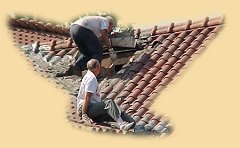
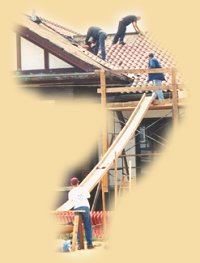
It was decided early in the project that the roof was the most important repair and would wait no longer, so a plan was formulated to start the removal of the Spanish tile and somehow cover the rotted areas until the spring of 2002. Our removal of the old crumbling chimney would also be included in this phase of the project. We were reluctant to begin because we had no expertise in this area, so we asked lots of questions and developed lots of ideas. We borrowed scaffolding from the City of Oregon and Ralph Bolhouse and we erected it across the front of the building. We built a slide that was propped against the scaffolding, and as the tile was removed, it was sent down the slide to a catcher below. With a great group of hard working volunteers that included Ken Giese, Dean Johnson, Jake Zimmerman, Steve Burdette, Dennis Kern, Kevin Hildebrand, Tim Zeigler, and Howard Fox, we had a third of the tile removed from the roof and stacked near the depot. The following weekend, contractor Dick Zimmerman volunteered his crew of Rob Zimmerman, Joel Newcomer, Gary Roos and Roger Watts, to make rafter repairs and install 1/2 inch plywood sheeting. A layer of 30 lb felt was applied, and then the entire area was covered with tarps for the coming winter.
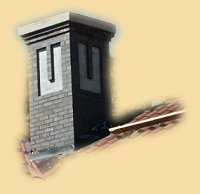 As spring and summer of 2002 arrived, work on a new chimney and preparations of the remaining two thirds of the roof began. During one particularly hot week, Jim Wilson and his men, John Winterton and Dennis King, were able to complete the chimney reconstruction in spite of the unbelievably hot weather. Their entire effort was a donation for which we will forever be thankful.
As spring and summer of 2002 arrived, work on a new chimney and preparations of the remaining two thirds of the roof began. During one particularly hot week, Jim Wilson and his men, John Winterton and Dennis King, were able to complete the chimney reconstruction in spite of the unbelievably hot weather. Their entire effort was a donation for which we will forever be thankful.
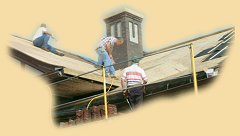 In anticipation of our approaching need to reinstall the tile roof, we had contacted Bob Raleigh of Renaissance Roofing in Belvidere Illinois, who specializes in clay tile roofing. Bob agreed to a working arrangement wherein we could use our volunteer labor to do considerable work on the depot roof, and he would provide the expertise to properly reinstall it. With the final cost estimate for Renaissance Roofing’s participation, I went to the Oregon city council for financial help, and they agreed to provide it.
In anticipation of our approaching need to reinstall the tile roof, we had contacted Bob Raleigh of Renaissance Roofing in Belvidere Illinois, who specializes in clay tile roofing. Bob agreed to a working arrangement wherein we could use our volunteer labor to do considerable work on the depot roof, and he would provide the expertise to properly reinstall it. With the final cost estimate for Renaissance Roofing’s participation, I went to the Oregon city council for financial help, and they agreed to provide it.
Jerry Stauffer was designated as coordinator of the roof project inasmuch as he had experience in carpentry and was not adverse to climbing and working off the scaffolding and on the roof. Enough additional scaffolding borrowed from Ralph Bolhouse and Renaissance Roofing was erected to surround the entire building. Then work on the rest of the roof was undertaken by a large and dedicated group of volunteers consisting of Tim Zeigler, Mike Roschi, Howard Fox, Richard Rhoads, Dennis Kern, Dan Taylor, Ken Giese, Dean Johnson, Jake Zimmerman, Kevin Hildebrand, Cory Fry, Don Stevens, Roger Watts, Jim Lowe, Richard Miller, Ralph Miller, Don Schier, Eldon LeFever, Darlene Schultz, Lisa Schultz and Gary Olszewski, a BNSF locomotive engineer living in Naperville, Illinois, who made a special effort to participate every weekend. This group worked nearly every weekend throughout the course of the summer; the work was hot, dirty, and physically demanding, but by fall’s arrival, they had been able to remove all of the remaining roof tiles, repair all of the rotted structural members, cover the entire area with 1/2 inch plywood sheeting, and apply a layer of 30 lb felt. The effort was remarkable.
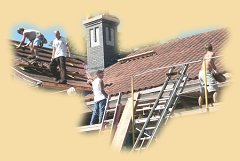

The crew from Renaissance Roofing began their reinstallation of the roof tiles in late September. The crew would vary from two to five men, and it was impressive to see them stand ten feet apart and throw eight-tile stacks from one to another in preparation for installation. Howard Fox volunteered to help, and lasted for half a day, but then realized that this was a younger man’s labor. He had never worked with tile before, but at least wanted to give it a try; when he broke a tile that he was nailing, he decided he had seen enough. Howard is an inspiration to all of us, and at 86 years young he has been a valuable asset throughout our restoration project.
The entire roof restoration phase, including copper flashing around the chimney and along the valleys, topped off with copper rain gutters and downspouts, had been originally estimated at a cost of $125,000. We completed the job for less than $30,000! We hope that the townspeople of Oregon and the City Council will always remember the volunteers whose labors made this accomplishment possible.
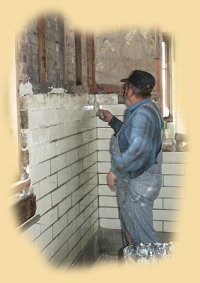
Interior Wall Tiles, Exterior Brickwork, and Future Plans
In some spots, previous roof leakage had caused serious damage to the interior wall tile mortar, and in other spots we had removed wall tiles in order to access some of the woodwork needing attention. Ed Giese volunteered his expertise in resetting the tiles and taking a look at our external brickwork. Prior to our shutting down for 2002, Ed was able to do a beautiful job with the interior tile; next summer he will make necessary repairs of the outside brickwork.
Early cold weather and lack of indoor heating have forced us to postpone outside stucco repairs and inside plasterwork until 2003 warmth arrives. A furnace will be next year’s big project.
Filling Our Bellies, Lifting Our Spirits
Throughout the course of our work on the depot, we have taken time to enjoy together some of life’s necessities, like food, reflection, and celebration.
 During our 2001 season we enjoyed a picnic organized by Cheri Wright as well as a dinner at the Roadhouse Restaurant. The dinner was provided by the City of Oregon in appreciation of the dedicated efforts of all our volunteers.
During our 2001 season we enjoyed a picnic organized by Cheri Wright as well as a dinner at the Roadhouse Restaurant. The dinner was provided by the City of Oregon in appreciation of the dedicated efforts of all our volunteers.
We brought to a close our first season of working together by restarting a tradition that goes back to passenger train days when station agent Roy Sherick would have a decorated Christmas tree in the Oregon depot waiting room. Our tree was donated by the Sinnissippi Forest Tree Farms. The city donated the lights to decorate the tree, and we asked citizens from Oregon to donate ornaments. Cheri organized our first open house, and it was held during the annual Christmas Candle Walk; her son Jake and daughter Dusti were dressed in costume as greeters. This was the first opportunity for citizens of the City of Oregon to see what had been accomplished at the depot.
Much had been accomplished in five short months and now it was time to plan for the coming spring. The city had been gracious in providing funds for materials, and people interested in our project had been generous with their many cash donations. There were times when people would stop in while we were working and just stick a folded-up check or cash in my pocket. During the holiday season I received several Christmas cards with checks enclosed. This project has been a humbling experience for me and I am proud to live in a city with such generous citizens. In the first few months we had over $10,000 in donations. The newspapers of both Oregon and Dixon were very helpful in printing news updates and feature articles about our project, helping to keep our effort in view of the public. The restoration of the Oregon depot is a very popular program and almost every walk-in visitor has a story to tell about the Oregon depot. We are making an attempt to record some of these stories, and the Oregon Literary Club is hoping to assemble them into a book as a fund raising effort.
 During 2002, in addition to the socializing enjoyed by the group of Oregon school alumni, the roof renovation crew enjoyed and appreciated some fine lunches provided by Cheri Wright and Darlene Schultz with Skip and Melva Johnson.
During 2002, in addition to the socializing enjoyed by the group of Oregon school alumni, the roof renovation crew enjoyed and appreciated some fine lunches provided by Cheri Wright and Darlene Schultz with Skip and Melva Johnson.
We wrapped up our second season with a picnic and a dinner for all the volunteers who participated during the year. We were open for the Autumn-on-Parade Festival in Oregon, and we had volunteers available for tours of the depot. We again have a Christmas tree in the waiting room of the depot, thanks again to Sinnissippi Forest Tree Farms who donated a magnificent tree. The tree is decorated beautifully, and for the open house during the annual Christmas Candle Walk, there were again costumed volunteers to show visitors through the building.
